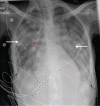When Two Syndromes Collide: Managing Fanconi and Refeeding Syndrome in a Single Patient
- PMID: 38344551
- PMCID: PMC10859126
- DOI: 10.7759/cureus.52169
When Two Syndromes Collide: Managing Fanconi and Refeeding Syndrome in a Single Patient
Abstract
Refeeding syndrome is the potentially fatal shift in fluids and electrolytes that may occur in malnourished patients after receiving artificial refeeding. Its hallmark feature is hypophosphatemia, although other electrolytes might also be affected. Fanconi syndrome is a generalized dysfunction of the proximal tubule characterized by proximal renal tubular acidosis (RTA), phosphaturia, glycosuria, aminoaciduria, and proteinuria. The etiology of Fanconi syndrome can be either acquired or inherited, and drugs, among them tenofovir, are a common acquired cause of this disease. We present the case of a patient with AIDS and polysubstance abuse who was admitted due to pneumonia, completed treatment, was then started on antiretroviral medication (ART) that included tenofovir alafenamide (TAF) and began presenting severe episodes of hypophosphatemia along with other electrolyte imbalances, leading the workup denoted in the case, severe complications and finally to the patient's demise. Most cases of tenofovir-related Fanconi syndrome are related to tenofovir disoproxil fumarate, but very few cases have been reported with TAF. Our case highlights this rare complication of therapy with TAF and how artificial feeding can contribute to severe electrolyte abnormalities and worsen outcomes.
Keywords: fanconi; hiv aids; infectious esophagitis; proximal renal tubule; recurrent hypoglycemia; refeeding; tenofovir alafenamide (taf); upper gastro-intestinal bleed.
Copyright © 2024, Gallegos Koyner et al.
Conflict of interest statement
The authors have declared that no competing interests exist.
Figures




Similar articles
-
Renal proximal tubulopathy in an HIV-infected patient treated with tenofovir alafenamide and gentamicin: a case report.BMC Nephrol. 2020 Aug 12;21(1):339. doi: 10.1186/s12882-020-01981-9. BMC Nephrol. 2020. PMID: 32787843 Free PMC article.
-
Fanconi syndrome due to tenofovir disoproxil fumarate reversed by switching to tenofovir alafenamide fumarate in an HIV-infected patient.Ther Adv Infect Dis. 2018 Jul 10;5(5):91-95. doi: 10.1177/2049936118785497. eCollection 2018 Sep. Ther Adv Infect Dis. 2018. PMID: 30224952 Free PMC article.
-
Acquired Fanconi Syndrome from Tenofovir Treatment in a Patient with Hepatitis B.Case Reports Hepatol. 2023 Jun 17;2023:6158407. doi: 10.1155/2023/6158407. eCollection 2023. Case Reports Hepatol. 2023. PMID: 37362623 Free PMC article.
-
Fanconi syndrome associated with use of tenofovir in HIV-infected patients: a case report and review of the literature.AIDS Read. 2005 Jul;15(7):357-64. AIDS Read. 2005. PMID: 16044577 Review.
-
Efficacy and safety of the regimens containing tenofovir alafenamide versus tenofovir disoproxil fumarate in fixed-dose single-tablet regimens for initial treatment of HIV-1 infection: A meta-analysis of randomized controlled trials.Int J Infect Dis. 2020 Apr;93:108-117. doi: 10.1016/j.ijid.2020.01.035. Epub 2020 Jan 25. Int J Infect Dis. 2020. PMID: 31988012 Review.
References
-
- A loss-of-function mutation in NaPi-IIa and renal Fanconi's syndrome. Magen D, Berger L, Coady MJ, et al. N Engl J Med. 2010;362:1102–1109. - PubMed
-
- Mistargeting of peroxisomal EHHADH and inherited renal Fanconi's syndrome. Klootwijk ED, Reichold M, Helip-Wooley A, et al. N Engl J Med. 2014;370:129–138. - PubMed
-
- The Fanconi syndrome of cystinosis: insights into the pathophysiology. Baum M. Pediatr Nephrol. 1998;12:492–497. - PubMed
Publication types
LinkOut - more resources
Full Text Sources
